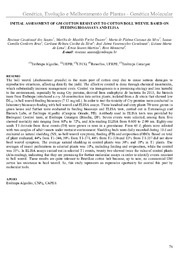Initial assessment of GM cotton resistant to cotton boll weevil based on feeding bioassays and Elisa.
Initial assessment of GM cotton resistant to cotton boll weevil based on feeding bioassays and Elisa.
Author(s): SANTOS, R. C. dos; DUARTE, M. de M. F.; SILVA, M. DE F. C. DA; BRAZ, L. C. C.; SILVA, C. R. C. DA; CAVALCANTI, J. J. V.; LIMA, L. M. de; MARTINS, E. S.; MONNERAT, R.
Summary: The boll weevil (Anthonomus grandis) is the main pest of cotton crop due to cause serious damages to reproductive structures, affecting directly the yield. The effective control is done through chemical insecticides, which substantially increase management costs. Control via transgene sis is a promising strategy and less harmful to the environment, especially by using Cry proteins, derived from endophytic Bt bacteria. In 2015, the biotech team from Embrapa introduced a cry 10-construction into cotton plants, isolated from a Bt strain that showed low DL50 in boll weevil feeding bioassays (7.12 mg/mL). In order to test the toxicity of Cry proteins were conducted in laboratory bioassays feeding with boll weevil and ELISA assays. Three hundred and sixty plants T0 were grown in green house and further were evaluated in feeding bioassays and ELISA tests, carried out in Entomology and Biotech Labs, at Embrapa Algodão (Campina Grande, PB).
Publication year: 2016
Types of publication: Abstract in annals or event proceedings
Unit: Embrapa Cotton
Keywords: Melhoramento de plantas
Observation
Some of Embrapa's publications are published as ePub files. To read them, use or download one of the following free software options to your computer or mobile device. Android: Google Play Books; IOS: iBooks; Windows and Linux: Calibre.
Access other publications
Access the Agricultural Research Database (BDPA) to consult Embrapa's full library collection and records.
Visit Embrapa Bookstore to purchase books and other publications sold by Embrapa.

